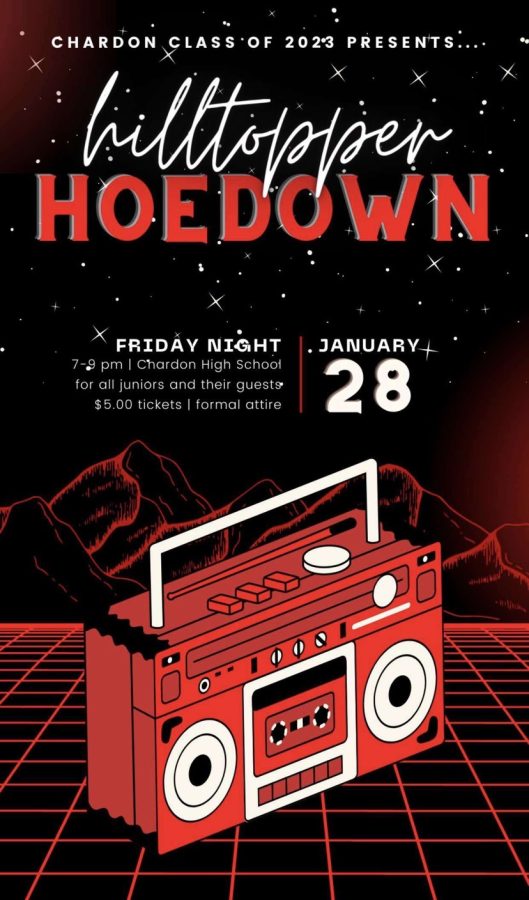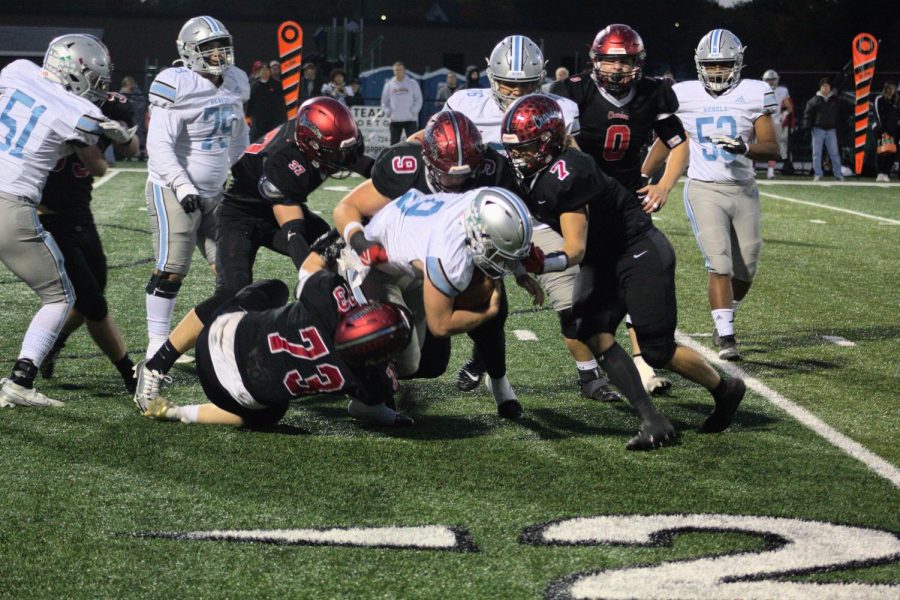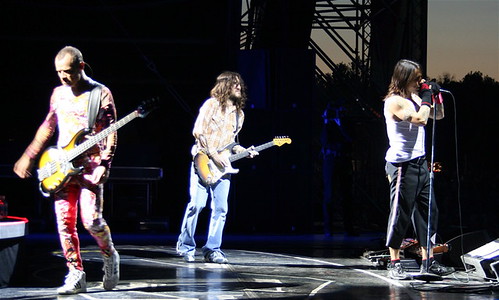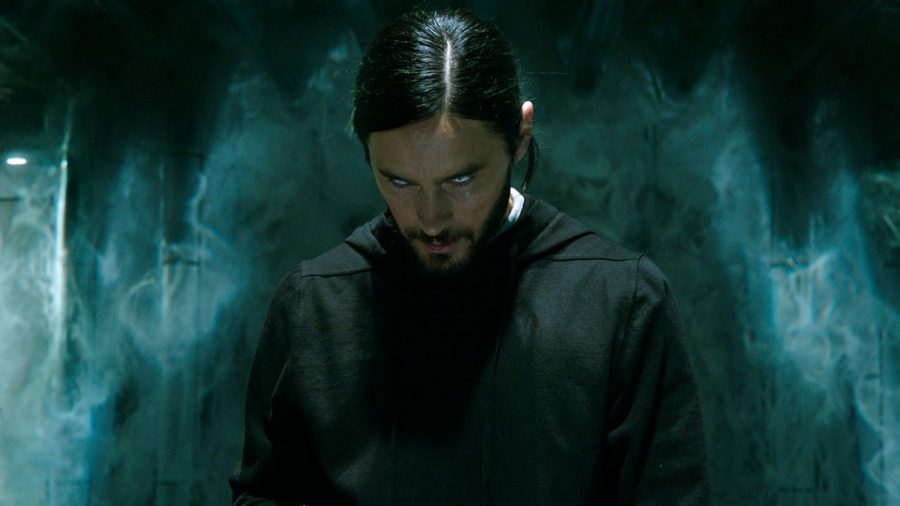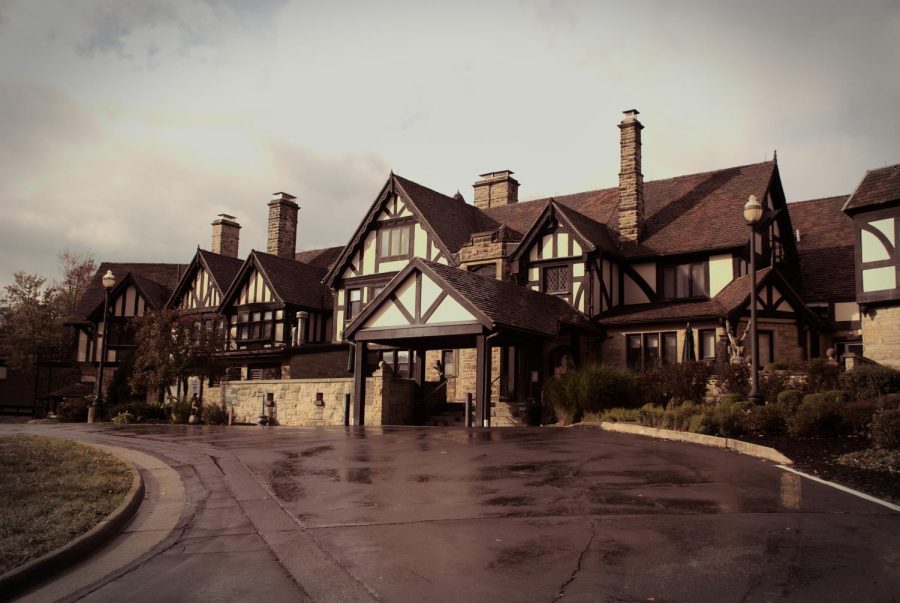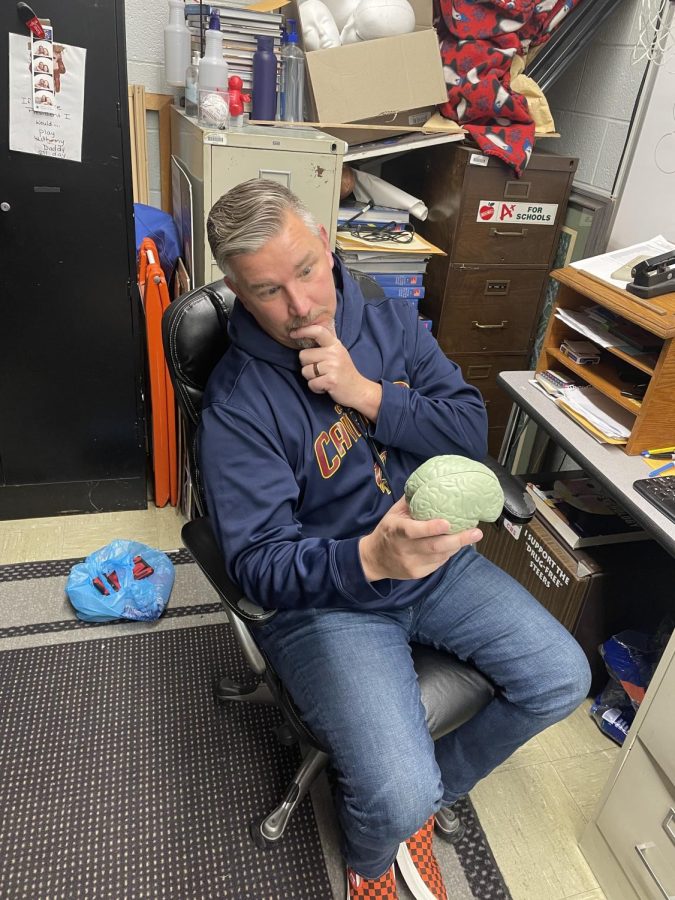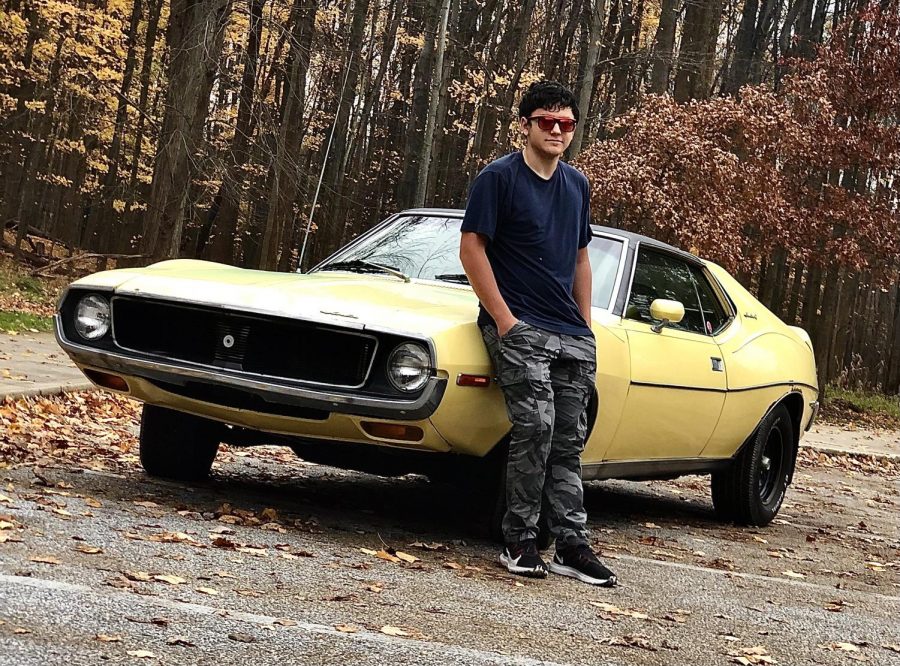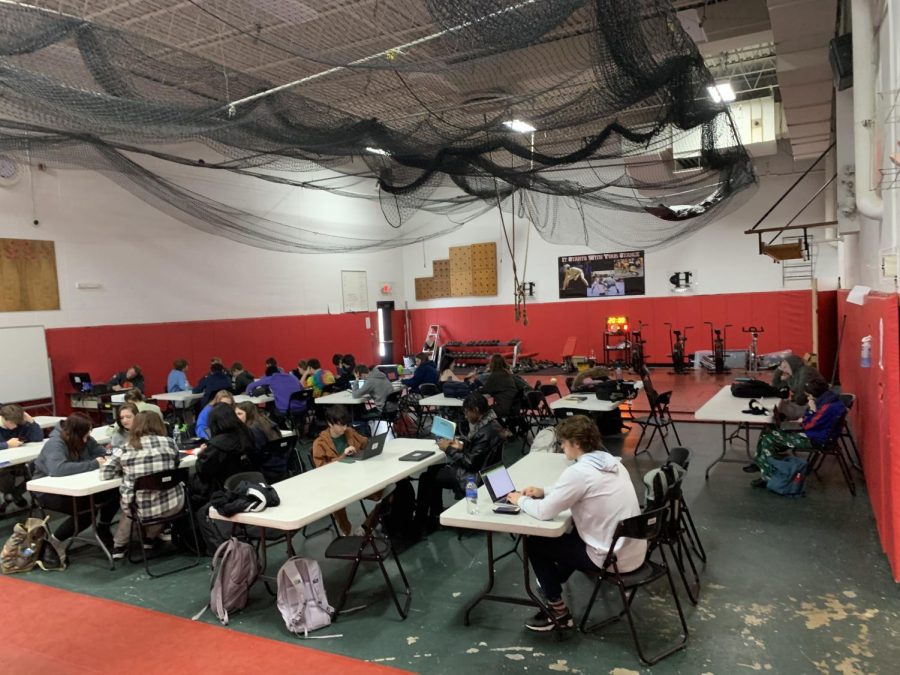Auto CHS: Evan Kuhl’s Javelin
December 21, 2021
Average cars are just hunks of metal put together by machines to turn a profit. Good cars are the same but done right. However, great cars are made by great stories, and this one has one of the greatest of them all.
CHS junior Evan Kuhl has recently been restoring his AMC Javelin, which he has received from his dad. This car has sat for many a year in storage after cooling issues have made it impossible to drive the car more than about 15 miles without the engine cooking itself on a skillet. But Kuhl has put hours upon hours upon hours into this machine and has gotten it into ship shape. That ship might as well be the Titanic though because there’s quite a bit to go on the restoration front. Firstly is the brakes, or rather, there isn’t. Kuhl has driven this car so much in the summer, and before that, the car has sat for so long, the drums have partially disintegrated. In layman’s terms, we’re operating on about 40% brakes here. This means it would be unwise to push the car on the roads at the moment, but that isn’t necessary. Just sitting in the car is enough to feel what made it so special.
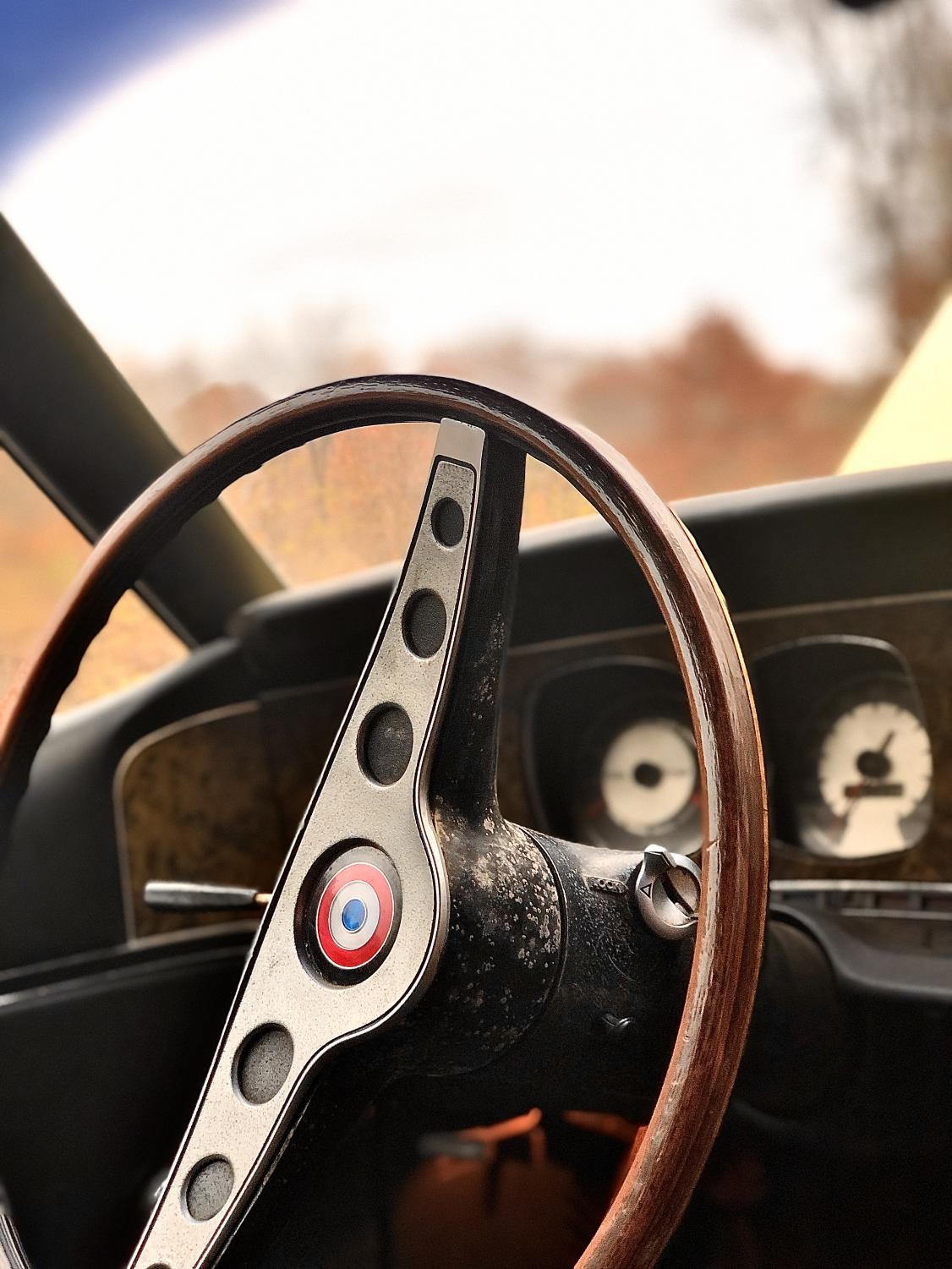
“You get a better-designed interior; you can see in some photos how, on the instrument cluster, there is some wood design and on the doors as well. The main distinguishable feature is a black vinyl leathery look.” Kuhl elaborated on the specifics of his own Javelin, it being the SST model. As I first sat down inside, many surprises were in store. Even the lap belts caught me off guard. Spending time in the car really highlights the distance the auto industry has traveled over the years (pun very much intended). So many norms during the time the car was made feel completely alien now. I mean, the steering wheel was large enough to have its own gravitational pull, the gas pedal was stiff and had virtually no feel, and the turn signal driver indicators were bright green lights flashing on a panel separate from the dashboard. Even though it is an auto, every time I had moved the shifter, it was met with an audible “kladunk” and a physical jolt before I was in my gear of choice.
In the midst of this state of confusion, I was still comfortable. The interior, as well as the exterior, truly breathes an air of timeless luxury mixed with period muscle brashness and inconvenience; and I love it. For example, the seats are soft and plush leather, cradling thee who enters their domain. But what is that I hear; you would like to move them? Balderdash! This is a muscle car, and you must be soft in the head if you’re under the impression the higher-ups care about such frivolous things as posture.
Now we’ve talked plenty about what the car is, and indeed it is a project car. But as we all know, a project car will never be truly finished, and because of this, there’s plenty still to go. What will “Java” be like in the future then?
“There are tons of possibilities for this, but right now I’d say we’re about 15% into the project,” said Kuhl. He has already mended the cooling problems that have kept the Javelin bed-ridden for the past 20 years, and he has also installed a 4-barrel carburetor to boost the horsies. But there is much more to go. The brakes will be replaced soon, with discs in the front and new drums on the back. Apart from this, the door is wide open. Once the car is at a spot he likes, he will take it to various car meets across northeast Ohio, with Fat Man’s Invasion and the Gasser Reunion being high on the bucket list.
To understand what made the Javelin and AMC so special, you’re gonna need some context.
What happens when an animal is forced to survive, with not quite enough resources to do so, in a cutthroat environment? In a word, they get radical. The wood frog can freeze itself solidly to withstand monumentally low temperatures. The chameleon can change colors, blending into its surrounding environment to hide from predators. It is natural selection because the natural world is a hostile place. Pressure breeds the unusual, and it was this kind of pressure that made American Motors Corporation what it was.
Once WWI was finished, all the trenches were cleared, and our boys were brought back home, we started buying cars at a rate no one had ever seen before. The Great War, however costly, had brought with it massive technical advancements, and this newfound tech trickled its way into the consumer auto industry. Not only that, but the US, with its arms dealing escapades to the allies, had actually made quite a bit of money through the war effort, and was not afraid to spend it on a better road system for all these new cars. The auto boom brought new companies out of the minds of young visionaries and made them a success, right up until the point where everything came crashing to a halt; hence, the Great Depression. Long story short, only the biggest beasts survived, and with WWII throwing the industry on its head once again for the fun of it, this truly was the catalyst for the auto business.
Once the dust had settled, three car companies emerged in the motoring capital of the world, known as Detroit. These conglomerates would be labeled as The Big Three; Ford, General Motors, and Dodge/Chrysler. They. Were. Massive. And that made it difficult for anything else to, um, exist.
You could call AMC the underdogs then. They formed out of a merger from Nash and Hudson (yes, the Doc Hudson kind of Hudson), two experienced manufacturers in their own right. While this managed to form the 4th biggest auto conglomerate in America, no small feat, they were nowhere near the monsters that were The Big Three. So, they had to operate in the niches. Regarded by Autocar magazine as “a small company deft enough to exploit special market segments left untended by the giants,” AMC knew their worth.
So essentially, they were a small company forced to survive, with not quite enough money to do so, in a cutthroat automotive market. Are you beginning to connect the dots here? Yeah, they had to get radical.
This is what endeared them to a lot of the American public and pop culture. There was a lingering mindset of “No, we aren’t going to buy your cars, but we sure are going to love them.” But this daring to be differently made for some pretty forward-thinking, and sheer bad timing. The AMC Rambler American pioneered the small economy car concept in the early ’60s, about a decade before the oil crisis hit and a tsunami of Japanese metal flooded onto American roads. The AMC Eagle, released in the late ’70s, was the very first SUV to hit the streets anywhere. I humbly ask you to look out into the high school parking lot when you get a chance and find a car type more common than the SUV out there. Not only that, but they took the Jeep Cherokee, and with pioneering unibody technology, turned it into the sales and cultural success that we see today.
But my most favorite example of their sheer quirkiness found its home in their sports division. AMC set out to build a muscle car, the only muscle car in reality, that put handling and balance over just sheer power. Nowadays, with gas prices rising and engines getting smaller, it’s a no-brainer, but back then; witchcraft! These ladies and gentlemen were the AMC Javelin.

Now I know that was a lot to take in, so here’s the skinny; AMC is the underdog in this story, and the Javelin is one of their odd but wonderful creations.
So here’s this company that’s causally reinventing the idea of what a muscle car can do. Interestingly, this was the only other car in the same auto segment as the Chevy Corvette; this American muscle car was so advanced that it transcended its contemporary rivals and started challenging supercars. Team Penske, a major racing team past and present used the Javelin for the Trans Am road car series and casually won a couple of championships with them.
Overall, we’ve seen the many faces of AMC. Their exploits of the small market segments made them pretty “versatile” as a company. Some would use the word “fragmented” instead. It’s this conflict of interests that drove many people away from AMC as a whole. It seems they’ve been going through an identity crisis from their inception to their demise. “Let’s make small cars. No, we should make muscle cars. Oh yeah, sports cars are in now, let’s get a slice of that cake. Wanna make a supercar? No, not yet. Muscle cars are good for now. Y’all All ever heard of a hatchback; let’s try that. How about really bad cars, let’s try that. No that’s not our fit, back to sports cars. Holy crap there’s this new thing called an SUV and it’s so quirky but let’s only kinda do it right. How about we try that really bad car thing again but this time we copy off of Renault and… we’re all fired.”
However, it endears me to them. We humans often fantasize about a life lived free of constraints and petty requirements. We lust over “being able to do what we want when we grow up”, even when we’ve already eaten through our prime years. But AMC’s wayward approach to what sector they should appeal to pretty much accomplishes this. They make what they want, using their resources to sometimes outright create a class of cars or bolster a segment right into the spotlight of pop culture. They’ll take on the Japanese in the compact hatch market, make a completely worse car, and yet people will love it more. And of course, they’ll take a muscle car, and with the foresight of a god, say “let’s make it smaller”.
The Javelin definitely feels old. Of course, it would, 1971 was a long time ago. The Kent State Massacre was still a piping hot topic, Marvin Gaye was still topping the charts, and Americans still feared Leonid Brezhnev would shove some Marx in their face and subject everybody to driving those sorry little Trabants. Consequently, the controls are either numb or don’t work, trim is falling off on the interior, and the car could really go for a new paint job. But in terms of automobiles, people often think the word old is interchangeable with lazy and difficult. They are not. This car can perform if asked to do so. This is reflected in its results. It couldn’t have casually won all its championships if it didn’t handle well. Making a car smaller, pretty obviously, makes it lighter. And as a personal hero of mine, Colin Chapman, once said, “the best way to make a car faster is to make it lighter.”
Here’s the problem though; the Javelin lulled many into a false sense of bravery while driving. Chapman knew how to make a car that performed exceedingly well and felt just as highly strung to drive. The steering was engaging, the pedals were inviting to the foot, the car was balanced to perfection. With the Javelin, AMC sort of stopped at the short part. This meant the car was definitely light, but not super stable. The large overhang on the front and short wheelbase meant sometimes the car rotated a bit too much. You needed some massive cojones to whip one of these around Sonoma or Road Atlanta in the early to mid-70s. But for our purposes, no whipping of said Javelin will happen until the car is in better working order, which should be soon.
Once in a while, a car company comes around that truly bucks the trends. Some, like Tucker and Packard, are squandered by the powers that be. Some, like Tesla, are bolstered by those same powers, and heralded as the future for us sorry, sorry little men. But not often does one of these monoliths gain its reputation by operating under the radar. AMC did exactly that; filling in the gaps, taking care of the odd jobs nobody else wanted to acknowledge. Through the good, the bad, and the ugly (Rambler, Pacer, and Gremlin), they played their game. And their game was making cool cars like the Javelin. I do wish Evan good luck in restoring his muscle car because I’d love to open the taps in it one day, or at least be there when it happens.
As I end my long folly of inquiries at Evan Kuhl in the main interview, one question still remains…
“Do you plan on this being the cover car for Chardon High School?”
“Yes sir, yes I do.”





